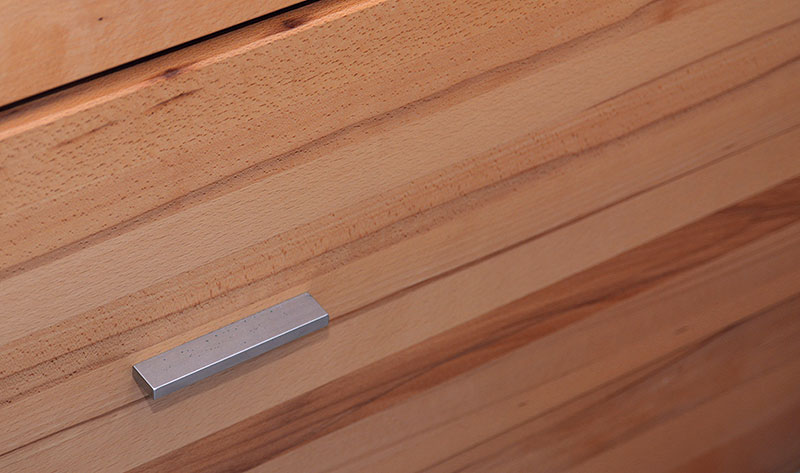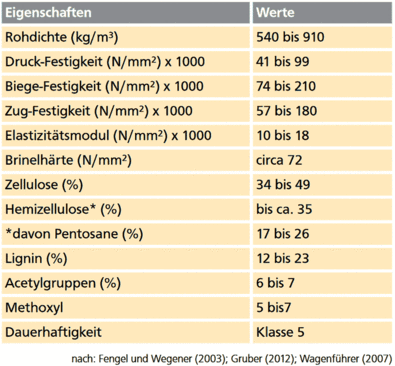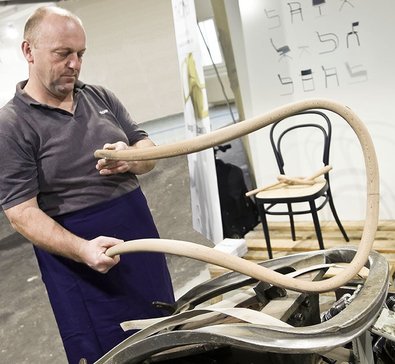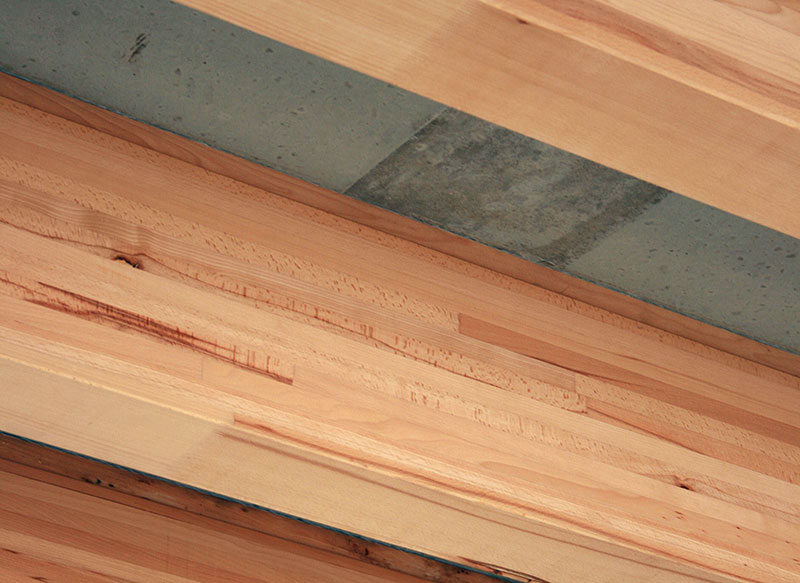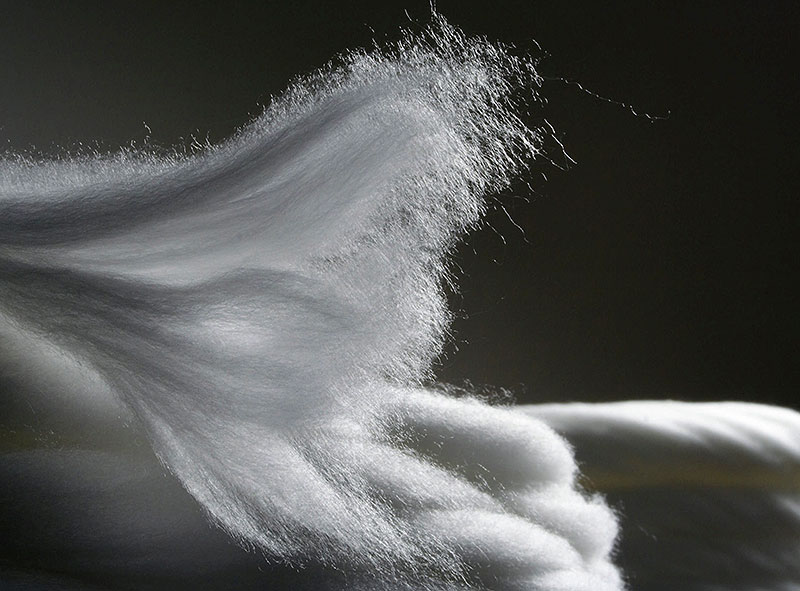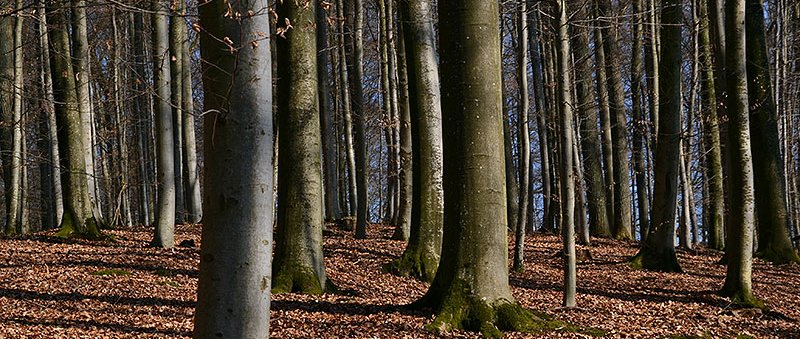The European beech has over 250 ways it can be used and has a wide area of demand, thus making it practically a jack of all trades. It is used in traditional wood products such as construction as load bearing beams and as a base commodity for the wood material industry. In addition, it is also used as a basis for alternative platform chemicals in the field of bioeconomy.
Beech wood and its characteristics
Beech wood is finely pored, homogeneously structured and is absent of conspicuous characteristics - the only exception being the shimmer from radial cuts. Sap wood and heart wood are the same pale yellow to red-whitish color. Trees with discoloration in the heart wood display a cloudy red color in the center of the stem. Beech trees with the red discoloration in the heart wood are used to produce decorative and valuable furniture (Fig. 1).
The medium to heavy wood has a high level of hardness (Table 1) which results in a high level of abrasion resistance. The wood can be bent exceptionally well when steamed and was used to manufacture popular coffee chairs over 150 years ago (Figure 2). The wood is not weather resistant, however, it can be easily impregnated with a sealant. The chemical characteristics (Table 1) are relevant for the pulp industry and bioeconomy.
Beech as construction timber
The use of beech in the construction sector can solve two problem areas:
- The presently high unused inventory of quality sawtimber and
- the demand for low dimensioned structural timber products with a great load-bearing capacity and a high modulus of elasticity.
Glued laminated timber(glulam) from beech or hybrid beams of beech (e.g. with a combination of spruce) are marketable (Figure 3). The cross-section of a glulam beam from beech, with same level of flexibility, is much smaller than that of spruce wood. However, the yield of glulam lamellae in comparison to evergreen wood is very low whereby the costs of production are proportionally high.
The creation of veneers from beech has a long tradition, but its use as plywood for large dimensioned boards and beams is still quite a novelty in the load-bearing segment of timber products. However, beech veneer plywood for use in construction has already been marketed for a number of years. Designing furniture with beech has potential due to the fine and lean characteristics of its wood. Powerful and strong it acts as a foundation for construction with beech.
By using the technology of wood moulding squared timbers of beech are compacted and warmed in a compressor into boards and then formed into tubes. In order to use such wood in load-bearing construction further development is needed.
The problem child veneer industry
Beech trunks of good quality can be used to produce plywood through the industrialized peeled veneer process. However, the production has been declining in Germany in the past years primarily due to high costs of wages and resources. Yields of veneer can be increased by the use of innovative technology: in a new procedure a machine automatically recognizes and sorts out the wood cracks and rotted braches and slices out the affected areas. By slicing out the areas of bad quality and merging the pieces back together in a dry compaction process the yield is then increased. However, this procedure is coupled with high costs of investment in kilns and is not available in an industrial scale.
Beech - refined and processed
Wood can be rendered into materials in which certain characteristics are even stronger than in their original form. This enables a high level of material resource utilization. Due to its unique characteristics beech wood is virtually predestined for use with special functions such as the medium-density fiberboard (MDF). In comparison with the longer and rough evergreen fibers, beech fibers deliver a particularly good quality when routing deep into the wood. It is also possible to penetrate into the cell walls of the wood. Wood based materials are modified after exposing them to heat, chemical reactions or exchanges from structure polymers. The "Belmadur technology" is a such a process and lifts the durability of beech wood into class 5, the same as that of teak wood.
Through the use of a biorefinery fossil fuels are to be replaces by sustainably produced biological substances. A lignocellulose biorefinery can process beech wood to produce commodity chemicals, which are then used to produce organic based products. As a result, it is possible to equally use all of the main components of the raw material (cellulose, hemicelluloses, lignin). As a result, it is possible to obtain chemical and biotechnological intermediates as well as binders and fillers for wood based materials and plastics.
High quality paper can be produced from cellulose. Meanwhile, even more is possible: Industrially isolated nanoscale cellulose fibrils or micelles serve as the raw material for transparent screen displays or bioplastics. In addition, cellulose is also the raw material for viscose fibers in the textile industry (Fig. 4).
Climate change - Say yes to beech!
Excellent wood characteristics plus a multitude of usage possibilities that has made the beech the tree of the future. In addition, there are ecological and economical merits as well since an admixture of beech not only reduces risks, but can also increase productivity and yields in pure spruce or pine stands. There are more than enough reasons to say yes to beech during climate changes due to its favorable wood, ecological and economic qualities.

